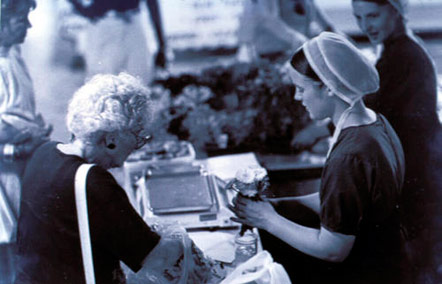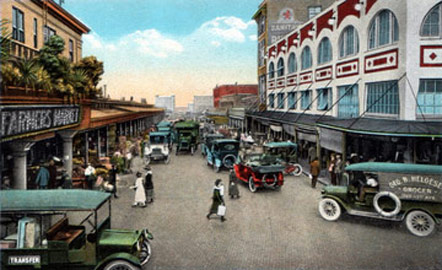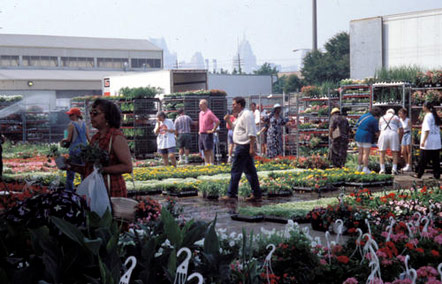“Much can be learned about what make places great by observing successful markets – and vice versa.”
In defiance of all the news about economic globalization covering the planet with big box stores, public markets are undergoing a sweeping renaissance as people around the world strive to rebuild local economies and keep human connections flourishing.
People love markets for so many reasons, yet in all PPS’s surveys asking people why they use markets, the reason that always pops to the top is the experience: seeing other people, opportunities for impromptu conversations, the unexpected sensory delights. This is what draws people back, again and again, to their favorite markets. But these qualities of spontaneity and sociability don’t just happen; a great market must be carefully planned as a public gathering place and managed within a sustainable business structure.
PPS has worked on markets all over the world and carefully studied the classic elements that go into creating successful markets or reviving old ones. And we’ve found that much of what makes a great market is identical to what makes a great public space. After all, markets are one of the primordial places for humans and much can be learned about what make places great by observing successful markets — and vice versa!
Underlying all PPS’s work is the “Power of 10” – the idea that at least ten focal points are necessary to make a great place, with each of those areas offering ten things to do. Public spaces exhibiting the Power of 10 offer the depth, meaning and visceral connections that create satisfying everyday experiences. This principle has a strong effect when applied to public markets, and lends them a competitive advantage over many other commercial forms. It is interesting to note that many innovations which have proven successful at public market – connecting with local farmers and producers, adding public seating, rebuilding a sense of community, adapting to site specific needs—are now being copied by savvy retailers such as Whole Foods.
Let’s look at the ways the Power of 10 expresses itself, drawing on PPS’s experience studying the best public markets around the world, to identify key qualities of popular public places and successful business models.
Taking the Power of 10 to the next level, here are 10 qualities within each of these:

The art of selling is second nature to Amish families from Lancaster County, Pennsylvania. Early practitioners of sustainable agriculture, most Amish children learn to sell at roadside stands or markets from their parents. At Philadelphia’s Reading Terminal Market, the Amish are a cherished presence and well patronized.
Right Vendors
Quality (second most popular reason why people like markets after the experience)
Appearance (easy to approach)
*Cleanliness*
Merchandising (presentation of product must be informative and distinctive)
Innovation (keeps customers coming back)
Competitive (customers must continually be won back by beating the competition with a superior choice)
Local (customers feel connected when they see ‘their own’)
3 Second Rule (three seconds are all you get to hook a new customer)
Attractiveness (best achieved through displays that are simple, abundant and artistic)
Service (good service makes people happy)

Many markets around the world still operate in cathedral squares and other sacred locations. Guatemala’s Chichicastenango market sets up in front of the cathedral to provide the devout with a convenient location to take care of both earthly and spiritual needs.
Right Location
Visible
Accessible
Memorable
Flow (easy to navigate and orient yourself)
Parking (requires management to ensure regular turnover)
Adjacencies (restaurants, retail, housing, transit, office workers in the neighborhood)
Confluence (places where people naturally come together)
Neutral (market should welcome everyone and not be any one group’s ‘turf’)
Scale (size should feel ‘right’ and be appropriate for the place)
Spin Off Opportunities (market activity should offer valuable source of customers for neighboring businesses)

China’s fabled Sunday Market in Kashgar is the gathering place for over a hundred thousand eager hagglers every week. The Chinese government has spent over $1 billion dollars improving and building markets in recent years.
Right Mix
Internal Competition (builds quality, variety and keeps prices reasonable)
Owner Operated (customers like dealing with the boss)
Choice (people love to comparison shop)
Different Price and Quality Levels (serves multiple tastes and income levels)
Right Vendors (vendors who love markets as a way of life)
Innovate (keep the customer engaged)
Local (consumer demand for local products is booming)
Balance (classic merchandise but always a bit of the new)
Clarity (stall by stall specialization works best)
Turnover (eliminate things that don’t work)

The Mercado Central in Minneapolis is a member-owned cooperative of 41 Latino businesses designed to recreate an authentic Latin American marketplace and serve as a cultural and community center.
Right Mission
Intent (set clear goals)
Create New Opportunities (provide entrepreneurs low-cost entry into retailing)
Self Sustaining (operational self sufficiency is crucial)
Nurturing Vendors (support for farmers, immigrants, fledgling entrepreneurs)
Socialization
Community Health (healthy food at low prices)
Local Culture (the town square for a community)
Create a New Frontier/Paradigm (self-determination for local economies)
Make People Happy

Chicago’s Daley Plaza is transformed into in open air market every Thursday during the growing season.
Right Public Spaces
Sense of entry (the market as oasis)
Seating (an opportunity for rest, chit-chat, snacking)
Maintenance (key to ongoing public enjoyment)
Shade (provide comfort in all seasons)
Things to Look at (other people, retail activity)
Art (aesthetic connection to a place)
Formal and Informal Qualities (do not over program or over design)
Welcoming (make sure everyone feels at ease)
Flexibility (able to sustain many activities)

Montreal has a thriving system of public markets throughout the city. Historic market halls have been renovated and new open-air markets are being located adjacent to Metro stops.
Right Connections
Reflect Community (a symbol of community identity)
Partners (involve other organizations whose mission overlaps with the market)
Public Transportation (easy to get to)
Bring Neighborhoods Together (linking different communities)
Bike Trails/Greenways (we’ll be seeing more and more of this)
Retail (mutual benefit with nearby stores)
Housing (a built-in customer base)
Local Economy (use the market as a hub for local revitalization)
Sense of ‘Giveback’ (demonstrate how market strengthens local connections)
Cross-Cultural (great venue for sharing foods, ideas and stories)

Pike Place Market, shown here in a vintage photo, is visited by more people in downtown Seattle than sporting and entertainment events combined. On a sales per square foot basis, Pike Place Market ranks in the top 10% of all commercial centers nationwide.
Right Economics
Sustainable Foundation (be realistic about financial underpinnings)
Fundraising (try to ‘bury’ your capital costs and open debt free)
Fair Rents (create a new level of ‘affordable’ business opportunity)
Community Health (this helps justify public investment)
Spin Off (markets are natural incubators for small businesses)
Job Creation
Encourage Investments (markets boost value of surrounding real estate)
Keeps $ Local (stems the flow of local dollars to out-of-town corporations)
Hand to Hand economy (endangered in a cashless society)
Transparent/Non-exploitative (accountability in all operations)

Detroit’s Eastern Market, one of the greatest classic market districts left in the United States, promotes Flower Day to colorfully kick off its spring season. The event is the market’s largest annual weekend drawing more than 100,000 shoppers.
Right Promotion
Stretch the Dollar (don’t overspend on expensive advertising)
Events/Demos (customers love them)
Public Relations (better than advertising)
Press Releases (stamps are cheap)
Market Image (keep it clear, compelling and consistent)
Partners (great venue for other groups with overlapping missions)
Passive Education (agriculture, health and community)
Builds Local Value
Community Connections (provides a forum for interaction)
Sponsorships/Fundraisers (encourage funders and civic leaders to get behind the market)

Small town markets have reappeared in town squares across America matching local farmers with city folk who are hungry for quality products as much as the social gathering. This antique postcard depicts local butchers on Pickering Square in Bangor Maine.
Right Value
Quality products
Quality experience
Boosts Local Economy
Creates Local Jobs
Social Capital (shared experiences build community)
Affirm a Sense of Place
Dividend (help save a farm when you buy that tomato)
Psychic Well-being (a fun way to feel good)
Local Food Systems
Sense of Local Ownership (it’s our market)

After completing a multi-million dollar renovation of its historic Findlay Market, the City of Cincinnati assigned management duties to a non-profit corporation formed specifically to operate the market with the mission of balancing entrepreneurialism and social goals. Many cities are transferring market management to such entities.
Right Management
Fair
Flexible
Firm
Open minded
Looking Ahead (the art of planning)
Promotion-Minded (promote the market at every opportunity)
Outreach (a diverse market is a strong market)
Capitalize on Niche Opportunities (small is profitable)
Good Relations (with vendors and customers)
Effective Behind the Scenes (whatever it takes to get the job done)
Front of the House (market managers are hosts as well, both for vendors and customers)